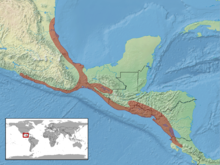Coniophanes piceivittis
| Coniophanes piceivittis | |
|---|---|
| Scientific classification | |
| Domain: | Eukaryota |
| Kingdom: | Animalia |
| Phylum: | Chordata |
| Class: | Reptilia |
| Order: | Squamata |
| Suborder: | Serpentes |
| Family: | Colubridae |
| Genus: | Coniophanes |
| Species: | C. piceivittis
|
| Binomial name | |
| Coniophanes piceivittis Cope, 1869
| |

| |
| Synonyms | |
Coniophanes piceivittis, known commonly as Cope's black-striped snake, is a species of small snake in the subfamily Dipsadinae of the family Colubridae. The species is endemic to Central America and Mexico, and is found in a wide range of habitats.[1][2]
Geographic range
C. piceivittis is found in Costa Rica, El Salvador, Guatemala, Honduras, southern Mexico, and Nicaragua.[2]
Reproduction
C. piceivittis is oviparous.[2]
Subspecies
Two
nominotypical subspecies.[2]
- Coniophanes piceivittis frangivirgatus J. Peters, 1950
- Coniophanes piceivittis piceivittis Cope, 1869
References
- ^ . Retrieved 20 November 2021.
- ^ a b c d Coniophanes piceivittis at the Reptarium.cz Reptile Database. Accessed 15 August 2016.
Further reading
- Cope ED (1869). "Seventh Contribution to the Herpetology of Tropical America". Proceedings of the American Philosophical Society, Philadelphia 11: 147–169. (Coniophanes piceiviitis, new species, pp. 149–150).
- Heimes, Peter (2016). Snakes of Mexico: Herpetofauna Mexicana Vol. I. Frankfurt, Germany: Chimaira. 572 pp. ISBN 978-3899731002.
- Peters JA (1950). "A New Snake of the Genus Coniophanes from Veracruz, Mexico". Copeia 1950 (4): 279–280. (Coniophanes frangivirgatus, new species).

